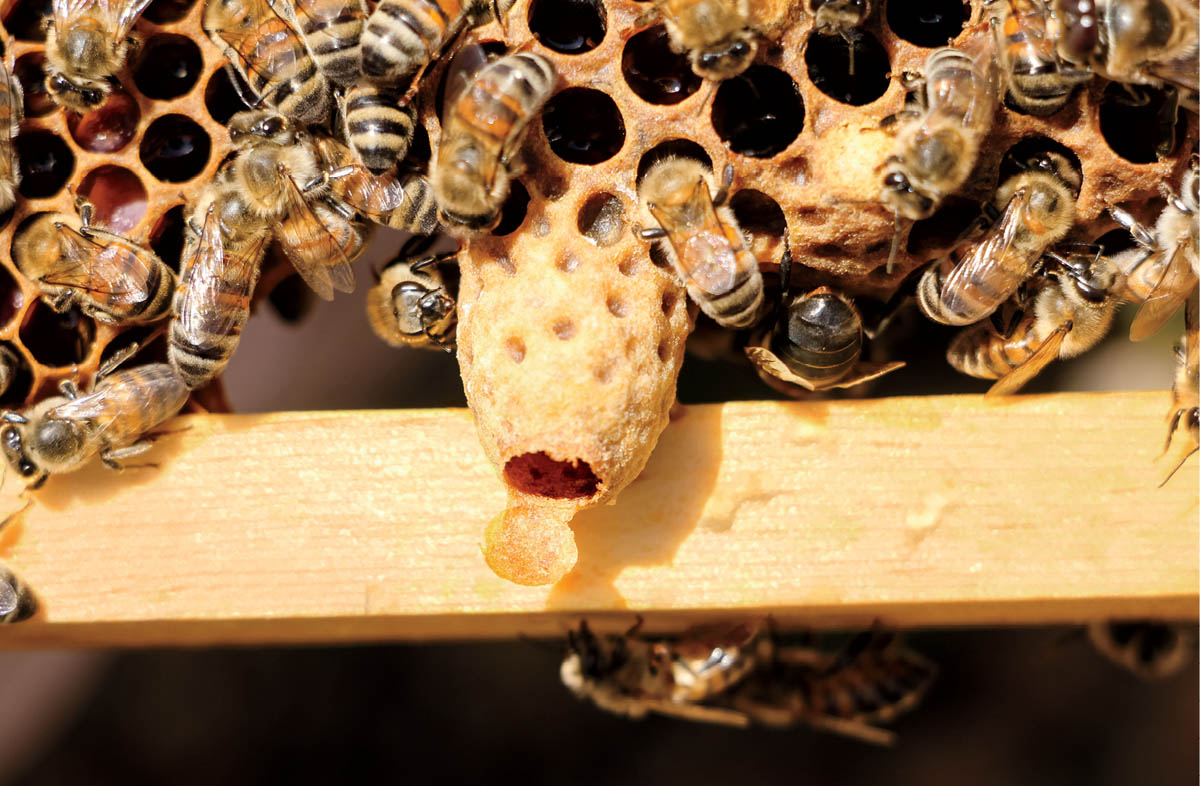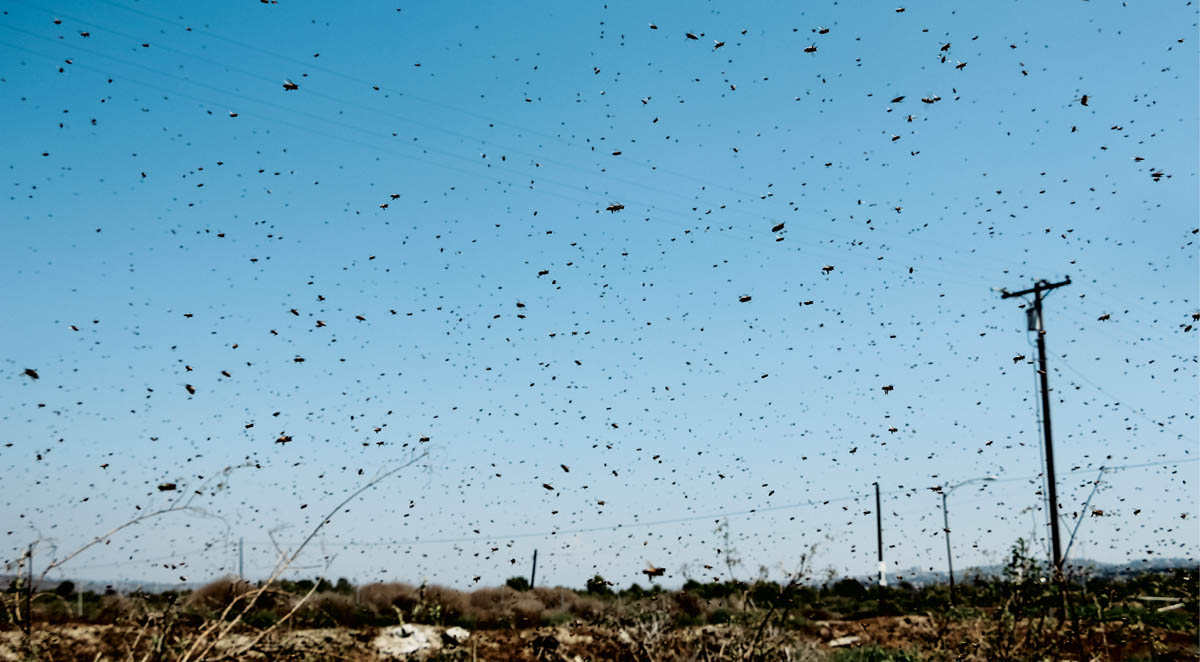
The cyclical nature of a colony makes it hard to distinguish a beginning, but since I must choose, I’ll start with the swarm. A swarm marks the birth of both a new queen and a new colony. It is often the beginning and sometimes the end of a queen’s life. Or it may mark only a new journey for a veteran queen, a rebirth!

When a colony grows to its full potential in the spring, the bees will conspire to swarm. Swarming is the way in which bees propagate their species and create new colonies — and with these new colonies come new queens! During the swarming process, the colony divides in two: roughly half the bees leave with the original queen to colonize a new location, while the rest stay behind and raise a replacement queen.
An astounding amount of preparation goes into this operation. First, workers construct small wax cups along the edges of the comb, called queen cups. Their queen then deposits an egg in each one, and the workers begin the process of raising her replacement. Over the next 16 days, these cups will be extended into full-size queen cells to accommodate the growing larvae inside. A colony typically raises between 10 and 20 new queens for a swarming event, but they usually don’t hatch until the original queen has left with the swarm.
These newly hatched queens then face two possibilities: they can compete against their rival queens in a battle to the death; or they can rally a small, secondary swarm and flee. Both come with considerable risk, but these challenges ensure that only the strongest queens survive.

Full-size queen cells, not yet capped
A queen bee is born into organized bedlam. She pops out of her cell with the suddenness of a champagne cork and scrambles across the combs at a frantic pace. Unlike mated queens, virgin queens are small, quick, and scrappy. Their abdomens are markedly shorter, barely reaching beyond their set of wings, giving improved mobility and speed.
She is one of potentially dozens of new queens in the hive and her survival depends on both timing and strength. If she is first to emerge, she has the advantage. She can sting her unhatched rivals to death through the walls of their cells. But with queen cells spread out across the hive, a virgin queen often does not have time to kill all her opponents before they emerge themselves.
Thus a virgin must fight for the position of queen bee in her colony. She is pitted against her sisters in a battle to the death. When two virgin queens come into contact, it’s believed that a pheromone in the abdomen triggers the fight. Yet they don’t always begin their battle straightaway. Some queens avoid each other for hours and may even run away from each other before a final confrontation.

The cell of a recently hatched queen
When the fight finally does begin, the queens latch onto one another, fiercely biting and tearing appendages. The battle can be as brief as 15 seconds or as long as 15 minutes. It ends when one queen successfully stings the other. The loser is often paralyzed and sometimes forcibly immobilized by surrounding worker bees, allowing the victor to deliver even more stings!
A queen possesses venom sacs that are three times the size of a worker’s. This is because she must dispatch a large number of rivals in a relatively short period of time. Victors sometimes emerge with torn wings or a missing leg, but these disabilities do not compromise their egg production, and the queens often go on to sustain healthy colonies. The losing queen usually dies within 15 minutes of the fatal sting and her body is ejected from the hive by an undertaker bee.

A common battle tactic of virgin queens involves one queen spraying the other with sweet-smelling rectal fluid. Although this is not often discussed, it is believed to occur in roughly half of all queen battles. Worker bees find surfaces and individuals sprayed with the floral-scented fluid highly attractive and will quickly gather around a queen who has been sprayed — immobilizing her. The rush of worker bees is sometimes so great, the movement of both queens will become restricted, bringing the battle to a temporary halt.
In instances where only the sprayed queen is immobilized, the opposing queen has the opportunity to penetrate the mass of worker bees and sting her easily. It is unclear whether spraying behavior is a cunning ploy designed to bring a swift victory or merely a means to a respite from battle. However, the appealing scent of a young queen’s rectal excretion is only temporary. Once the victorious queen matures, her feces take on a rancid odor.

A dead virgin queen ejected from the hive
While the new queens develop, special worker bees, called scout bees, leave the hive in search of potential nesting sites. Scout bees can spend up to 30 minutes measuring and evaluating a possible home. If they discover a worthy space, they return to the nest and present their findings by doing the waggle dance. Other scouts follow the directions given to them via the dance and judge the location as well. If they like it, they too return to the hive and begin to dance.
Eventually, the scouts narrow down their choices to two or three potential nesting sites, each with their own group of dancers. This process has been compared to our own democratic process with scout bees essentially voting for the location they like best by means of a dance-off.
Back at the hive, other bees must prepare the reigning queen for departure. Queen bees make poor fliers because of their size, so a queen must lose roughly a third of her body weight before leaving with her swarm. To achieve this, the queen goes on a diet. She is even encouraged to exercise by workers who chase her around the hive! These strict personal trainers coerce her into continuous movement by physically harassing her. They shake, push and even bite the queen.
Cruelly, while the queen’s diet is restricted, the workers gorge themselves on honey, filling their honey stomachs to their fullest. This behavior is the bee equivalent of packing a suitcase. They will need all the honey they can carry to start their new hive. Upon departure, about a third of a swarm’s weight comes from the honey reserves they carry. And while the queen is now trim and nimble, the extra weight the workers carry makes them fat and lethargic.
The lazy ambience of a colony about to swarm feels counterintuitive. They hang languorously from the combs and near the entrance of the hive, hardly moving at all until the scout bees return to instigate their flight. It typically takes the scouts over an hour to motivate their sisters for takeoff. The scouts travel excitedly from bee to bee to deliver the vibratory signal that will stimulate their flight muscles.
Once the workers have warmed up their muscles, the scouts begin their second signal: a buzz-run. They charge madly through the hive buzzing in bursts and bowling over their laggard hive mates. Their excitement triggers a mass exodus and the hive is suddenly transformed. The still air is filled with a tremendous buzz and bees rush toward the entrance in a frenzy to take flight.
The queen is pushed and carried by this torrent out of the hive. She lifts into the air and joins the cloud of swirling bees above.
A swarm in flight is one of my favorite sights. I have chased them down streets on foot and by car. I have stood, hypnotized by wonder, in a swarm’s center. I have even been chosen as a suitable object for one to land on!
Swarms usually need to take breaks on their way to their chosen nest site and can sometimes land in a rather silly or inconvenient location. I once got a call about one gathered on a truck tire! In spring, when swarms are most common, I spend so much time rescuing them, I even encounter them in my dreams.

A swarm in flight